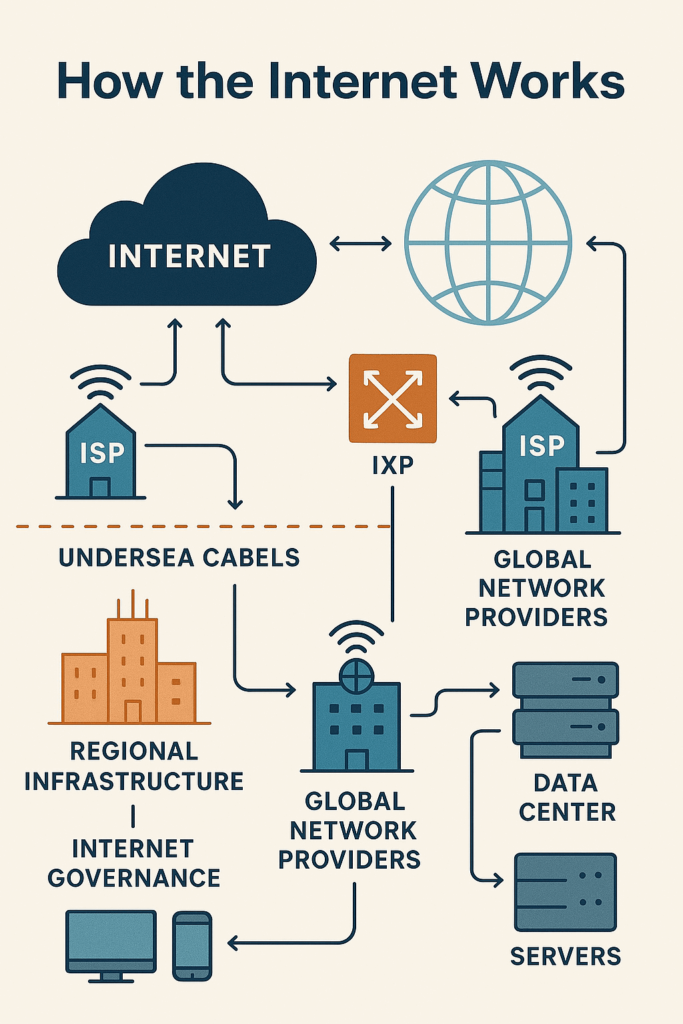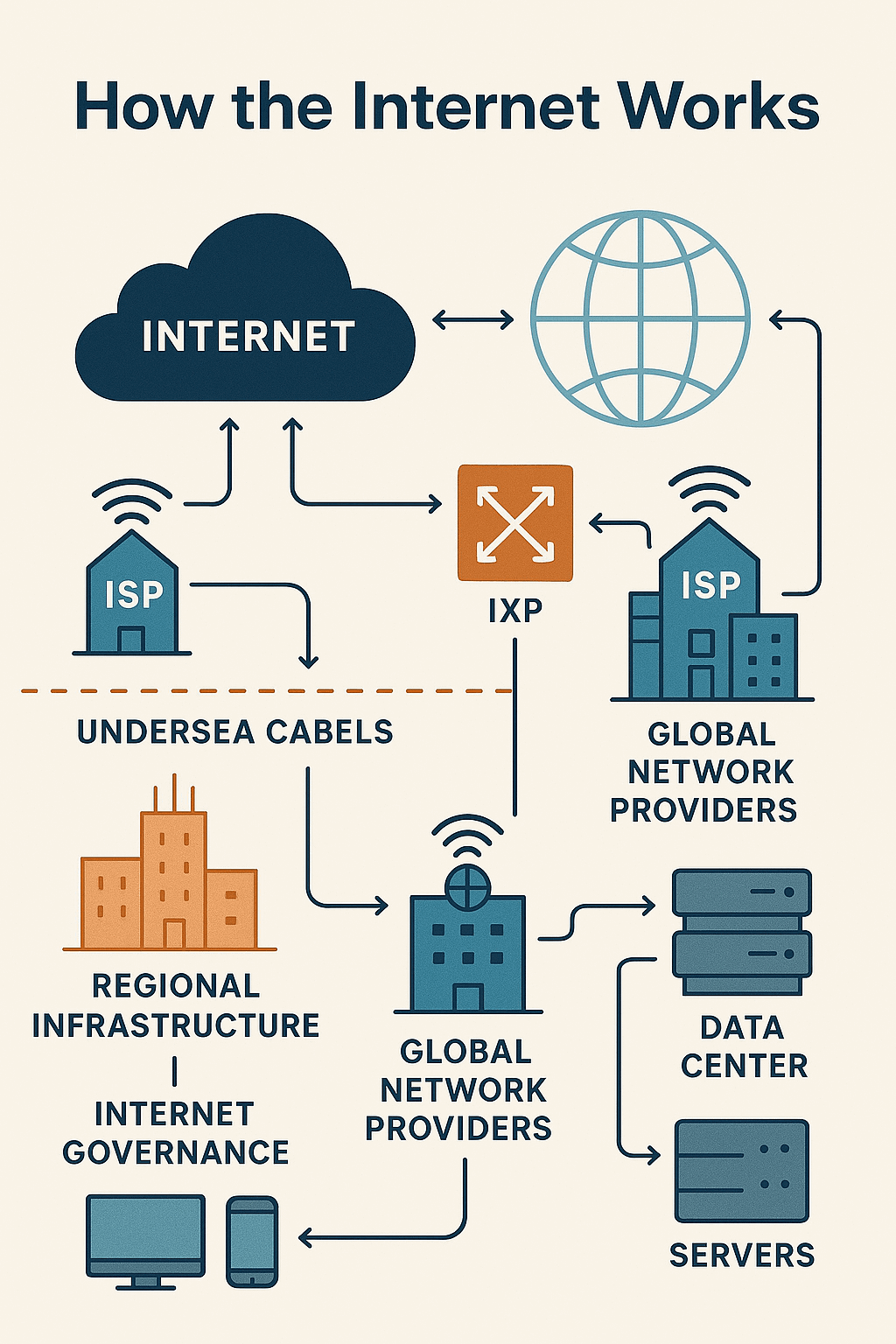How the Internet Works: A Complete Guide
Introduction
The Internet is one of the greatest technological innovations of all time. It connects billions of people and devices worldwide, enabling communication, business, entertainment, education, and countless other activities. But how exactly does the Internet work? What are the fundamental technologies, protocols, and infrastructure that make this global network possible?
In this detailed guide, we will explore the entire working mechanism of the Internet, from its underlying architecture to data transfer protocols, cybersecurity, global infrastructure, and the future of Internet technology.
1. What is the Internet?
The Internet is a vast global network of interconnected computers and devices that communicate using standard protocols. It allows information to be shared instantly across the world, enabling a wide range of services such as web browsing, online gaming, cloud computing, and more.
1.1 History of the Internet
The concept of a global computer network dates back to the 1960s, when the U.S. Department of Defense developed ARPANET (Advanced Research Projects Agency Network). This was the first successful implementation of a packet-switching network, which laid the foundation for the modern Internet.
Key milestones in the evolution of the Internet include:
- 1969: ARPANET successfully connects four computers.
- 1983: TCP/IP protocol becomes the standard communication protocol for ARPANET.
- 1989: Tim Berners-Lee invents the World Wide Web (WWW), making Internet navigation easier.
- 1990s-2000s: Widespread adoption of email, web browsers, and e-commerce.
- 2020s: Growth of 5G networks, cloud computing, and AI-powered Internet services.
2. Key Components of the Internet
The Internet is built on several fundamental components that work together to facilitate data transfer and communication.
2.1 Servers and Clients
- Servers: Powerful computers that store and serve data (e.g., websites, emails, and cloud storage).
- Clients: Devices such as smartphones, laptops, and tablets that request data from servers.

2.2 IP Addresses (Internet Protocol Addresses)
Every device on the Internet has a unique numerical identifier called an IP address. There are two types:
- IPv4 (Internet Protocol Version 4): Uses a 32-bit address, e.g.,
192.168.1.1. - IPv6 (Internet Protocol Version 6): Uses a 128-bit address, e.g.,
2001:db8::ff00:42:8329.
IPv6 was introduced to overcome the limitations of IPv4, as the number of available IPv4 addresses is running out.
2.3 DNS (Domain Name System)
DNS acts as the “phonebook” of the Internet. It translates human-readable domain names (e.g., google.com) into IP addresses, allowing browsers to locate and load websites.
2.4 Data Packets and Packet Switching
The Internet uses packet switching, where data is broken into small packets and transmitted across the network independently. These packets are reassembled at the destination.
Benefits of packet switching:
- Efficient data transmission
- Redundancy and fault tolerance
- Improved network scalability
2.5 Routers, Modems, and Switches
- Routers: Direct data packets between different networks and determine the best path.
- Modems: Convert digital data from devices into signals that can travel over communication lines.
- Switches: Connect devices within a local network, allowing them to communicate efficiently.
3. How the Internet Works Step-by-Step
- User Requests a Website: When you enter a URL in your browser, your device sends a request to a DNS server to fetch the website’s IP address.
- DNS Resolves the Domain Name: The DNS server returns the IP address to your device.
- Data Packets Travel Through the Network: The request is transmitted across routers and servers.
- Web Server Processes the Request: The requested website’s server processes the request and sends back data in packets.
- Data is Reassembled and Displayed: Your browser reassembles the packets and displays the webpage.
This entire process happens within milliseconds!
4. Global Internet Infrastructure
4.1 Undersea Cables
The backbone of the Internet consists of fiber-optic undersea cables that transmit data between continents at high speeds. These cables are laid on the ocean floor and maintained by global telecom providers.
4.2 Internet Exchange Points (IXPs)
IXPs are physical locations where different networks exchange Internet traffic. They help reduce latency and improve data transfer efficiency.
4.3 Internet Service Providers (ISPs)
ISPs are companies that provide Internet access to users. They connect customers to the broader Internet using fiber, cable, DSL, or satellite connections.
4.4 Data Centers and Cloud Infrastructure
Large data centers store and manage vast amounts of data. Companies like Google, Amazon, and Microsoft operate cloud infrastructure that hosts applications, websites, and digital services.
5. Internet Governance and Policies
5.1 Key Regulatory Organizations
- ICANN (Internet Corporation for Assigned Names and Numbers): Manages domain names and IP addresses.
- IANA (Internet Assigned Numbers Authority): Oversees IP address allocation.
- ITU (International Telecommunication Union): Regulates global telecommunications standards.
5.2 Government Regulations and Censorship
Many countries enforce Internet regulations, including data privacy laws, content censorship, and cybersecurity measures.
6. Cybersecurity and Internet Safety
6.1 Common Internet Threats
- Hacking & cyberattacks
- Phishing scams
- Malware & viruses
- DDoS (Distributed Denial of Service) attacks
6.2 How to Stay Safe Online
- Use strong passwords & two-factor authentication.
- Enable firewalls and antivirus software.
- Be cautious with suspicious links and emails.
7. Future of the Internet
The Internet continues to evolve with new technological advancements.
- 5G & 6G Networks: Faster Internet speeds and lower latency.
- Quantum Computing: Ultra-secure data transmission.
- AI & IoT: Smart, interconnected devices.
- Decentralized Web (Web 3.0): More privacy-focused, blockchain-powered Internet.
- Satellite Internet (e.g., Starlink): Expanding Internet access to remote areas.
Conclusion
The Internet is a vast and complex system that enables global connectivity and communication. Understanding its working principles, including global infrastructure, ISPs, cybersecurity, and future trends, allows us to appreciate the technology that drives our digital world.
As the Internet continues to evolve, it will play an even bigger role in shaping our future, revolutionizing industries, and connecting people like never before.



